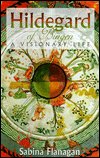Hildegard von Bingen. A visionary life

Sabina Flanagan
New York:1989, 1990
When Henry, fourth of that name, ruled the Holy Roman Empire, there lived in hither Gaul a virgin famed equally for the nobility of her birth and her sanctity. Her name was Hildegard. Her parents, Hildebert and Mechthilde, although wealthy and engaged in worldly affairs, were not unmindful of the gifts of the Creator and dedicated their daughter to the service of God. For when she was yet a child she seemed far removed from wordly concerns, distanced by a precocious purity. (Vita, BkI)
I
This is how Godfrey a monk from Disibodenberg who acted as Hildegard's secretary and provost to the nuns at Ruperstberg, introduces his subject in the first book of his Vita Sanctae Hilldegardis (Life of St Hildegard). When he died in 1176 he left the work unfinished and it was not until a decade later, when Hildegard herself had been dead for some years, that Theodoric of Echternach, a famous monastery in the diocese of Trier, wrote the second and third books and added the prefaces.
Although one of her biographers had been in daily contact with Hildegard and in a position to ask about her early life, much information which might be considered important or even essential by a modern reader is missing from the Vita. (...) On the other hand, selections from Hildegard's correspondence are included in the Vita. Even more valuable is Theodoric's incorporation, in the second and third books, of lenghty autobiographical passages from an otherwise unknown works of Hildegard.
(...)
Although Hildegard's learning and approach may have represented something of a back water in her own day, the wave of scholasticism has long since peaked. Yet aspects of Hildegard's thought have contributed to a broader and more enduring stream of speculation about the interrelations of divinity, humanity, and the natural world.
Enviar um comentário